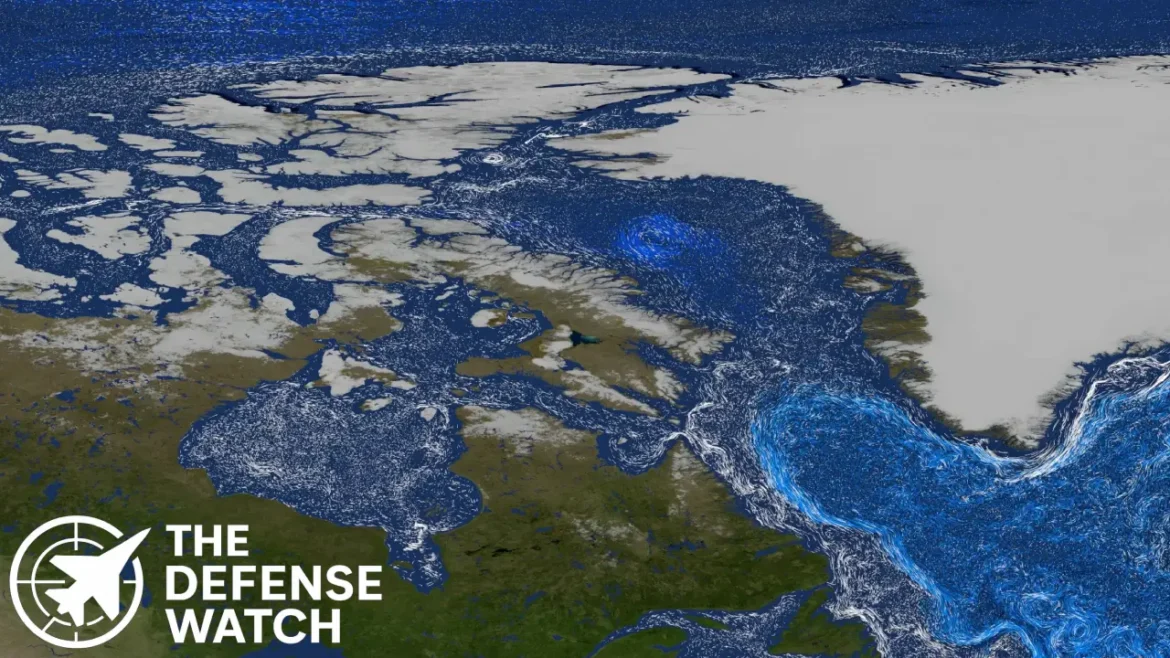Table of Contents
Greenland Ice Melt and Ocean Ecosystems: What’s at Stake
The rapid pace of Greenland ice melt ocean ecosystems is emerging not just as an environmental concern, but as a domain of strategic importance for defense, logistics and geopolitics. The massive mass loss from the Greenland Ice Sheet (GrIS) and its cascading effects on ocean circulation, marine life and seabased operations warrant close attention.
Satellite and field data show the Greenland Ice Sheet has been losing mass each year, with the 2021–22 mass-balance year recording approximately –146 ± 64 Gt of ice loss — equivalent to about 0.4 mm of global sea level rise. Freshwater and sediment discharged into fjords and the adjacent seas are altering stratification, salinity and nutrient fluxes — with direct consequences for ocean ecosystems.
This piece explores how Greenland’s ice melt is re-shaping ocean ecosystems, what that means for naval and maritime operations and the broader strategic implications.
How Greenland Ice Melt Impacts Ocean Ecosystems
Freshwater Dumping and Circulation Disruption
As meltwater from the Greenland Ice Sheet pours into adjacent seas, it weakens the salinity and density of surface waters. Observations indicate that surface salinity on the Northeast Greenland Shelf has declined by approximately 0.2–0.5 g/kg since the early 2000s, with stronger seasonal freshening inside fjords reaching up to 1–2 g/kg.
his gradual freshening affects vertical mixing and stratification across the Greenland and Labrador Seas. It also contributes to a measurable weakening of the Atlantic Meridional Overturning Circulation (AMOC) — a key component of the global ocean conveyor that regulates North Atlantic climate.
Research indicates that the AMOC has weakened by approximately 15–30 percent since the 1950s, according to multiple oceanographic datasets and reconstructions.
Greenland meltwater is a significant factor in this slowdown — adding freshwater that disrupts deep-water formation — but scientists emphasize it is not the only driver, with changing wind patterns, Arctic sea-ice loss, and broader climate oscillations also contributing.

Nutrient Upsurge and Phytoplankton Booms
Interestingly, meltwater plumes also bring deep-ocean nutrients upward, stimulating phytoplankton blooms. A recent study showed that runoff beneath the active western-coast glacier (Jakobshavn Glacier / Sermeq Kujalleq) delivers iron and nitrate to surface waters, boosting primary productivity.
Such nutrient pulses can cascade upward through the food web. Increased plankton supports richer populations of zooplankton, fish and even marine mammals. But the new productivity may also be uneven and transient — creating ecological instability rather than steady growth.
Ecosystem Shifts and New Species Distributions
Warmer coastal waters and melting sea-ice are altering species ranges. In Southeast Greenland, for example, the absence of pack ice in summer and warmer currents have allowed boreal fish and even certain whales to expand into waters where they were previously rare.
This shift destabilizes historic food-webs and local fisheries — with implications for Arctic coastal communities and the maritime domain.
Sediment Flux and Chemical Changes
Beyond freshwater and nutrients, sediment discharged from marine-terminating glaciers is significant. One study estimated that the Greenland Ice Sheet delivers sediment equal to 8 % of the global ocean sediment budget despite representing only ~1.1 % of global freshwater flux.
This sediment influences light penetration, bottom habitats and benthic communities. Additionally, combined meltwater and sea-ice melt processes have been linked to enhanced ocean acidification in fjords of North Greenland.

Strategic and Defense Implications for Maritime & Arctic Domains
Navigation, Base Access and Sea-Lane Vulnerabilities
The Greenland region is rapidly evolving as an operational theatre. Ice retreat opens new sea-lanes and potentially reduces transit times. But at the same time, freshened, stratified waters may affect sonar propagation, submarine stealth and undersea surveillance capabilities.
Additionally, changed ecosystems mean altered seabed sediments and biofouling regimes — factors that can degrade sensors or change mine-clearance dynamics in littoral Arctic waters.
Ecosystem Changes and Strategic Competition
Marine ecosystem shifts may trigger resource competition — for example, fisheries moving into previously inaccessible Arctic waters. Nations or alliances may deploy observational platforms or patrols to secure newly rich fishing grounds or seabed-mineral prospects. These deployments will require knowledge of how Greenland’s meltwaters influence marine habitats and hence the viability of platforms.
Ocean Circulation Slowing and Climate Security
From a geostrategic lens, the slowing AMOC driven by Greenland ice-melt has broad climate-and-security implications. A weakened AMOC could trigger colder winters in Europe, altered monsoon patterns and more extreme weather globally. Governments and militaries will need to prepare for increased humanitarian-assistance missions, infrastructure stress and even geopolitical instability tied to climate impacts.
Intelligence, Surveillance & Reconnaissance (ISR) in Changing Seas
Changing salinity, stratification and biological regimes complicate acoustic signatures, under-ice navigation and unmanned underwater systems (UUV) operations in the Arctic. Defense planners must account for dynamic ecosystems when calibrating sensors or planning ASW and submarine operations.
Context and Outlook — Why the Defense Community Should Care
Since 1998, the Greenland Ice Sheet has lost mass every year. The processes that govern ice-ocean interaction at marine margins remain poorly observed and hard to model.
From a defense and aerospace perspective:
- Understanding how freshwater discharge alters ocean stratification is vital for submarine, surface-ship and sensor operations.
- Ecosystem shifts may serve as indicators of broader system change — early-warning for logistics disruption, increased migration, or even military security risk in the Arctic.
- New sea-lane access may open in the Greenland/North Atlantic region — but they’ll come with environmental and operational caveats.
In short, the intersection of Greenland ice melt ocean ecosystems is no longer purely academic: it is part of the operational environment for future defense planning.
Recommendations for Defense & Policy Stakeholders
- Increase investment in high-latitude ocean monitoring systems: salinity, stratification, nutrient load, sonar propagation conditions.
- Integrate melt-water / ecosystem modelling into naval planning, submarine operation training and under-sea domain awareness.
- Treat Arctic marine ecosystems as strategic terrain: anticipate migration of commercial fish stocks, opening of seabed access and associated security competition.
- Monitor changes in the AMOC and other major circulation systems: these influence climate-driven geo-security scenarios.
- Encourage multidisciplinary collaboration between glaciologists, oceanographers, defense analysts and maritime operational planners.
FAQs
Warming air and ocean temperatures accelerate surface melt and submarine melting of marine-terminating glaciers. Studies show ocean-driven melt is particularly significant in deep fjords.
Because meltwater and sediments alter salinity, stratification, nutrient fluxes and sediment loads — all of which influence primary productivity, species composition and food-web dynamics.
Changing ocean conditions affect sonar and UUV performance, create new navigation opportunities and risks, and trigger ecosystem shifts that may drive resource and security competition in the Arctic/North Atlantic region.
Some effects may persist even if melting slows, because ocean and ecosystem responses can be delayed, nonlinear and include tipping-point behavior.
It refers to the combined phenomenon of Greenland’s ice melting into the ocean and the resulting impacts on ocean ecosystems — including freshwater discharge, nutrient/sediment transport, circulation changes and biotic responses.


8 comments
[…] delay the flow of critical information to congressional defense committees, which rely on candid military briefings for oversight of operations, budgets, and procurement […]
[…] detection, digital radar warning receivers and jamming capability, enabling the F-16 to operate in dense electromagnetic spectrum threat environments. It is also architected to work in conjunction with the SABR AESA radar (AN/APG-83) on modernized […]
[…] (Article 9), domestic political sensitivity about engaging in another country’s defence, and U.S. strategic ambiguity about the thresholds triggering military commitment to Taiwan. These factors combine to produce a scenario where Japan might act first or […]
[…] strategy pivots to the Arctic, where icebreakers and Northern Fleet bases secure Northern Sea Route claims. Integration of […]
[…] space becomes increasingly central to military operations and strategic competition, the sustainability of the orbital environment emerges as a critical defense issue. The […]
[…] Strategic Implications in the Indo-Pacific:Russia’s pitch to India reflects a long-term vision. If India accepts and co-produces the Su-57E, New Delhi could develop a homegrown stealth ecosystem, weakening U.S. leverage and shifting the regional defense balance. This comes amid India’s development of its own Advanced Medium Combat Aircraft (AMCA), and could act as an interim solution for India’s fifth-generation ambitions. […]
[…] missile systems and precision-guided munitions could follow in the coming months, potentially reshaping operational strategies across the conflict. The strikes serve as both a tactical advantage and a message of capability to […]
[…] shift toward large-scale combat operations and strategic competition. The release of the Army’s Arctic Strategy emphasized operational mobility, resilience, and situational awareness in polar climates, where navigation, […]